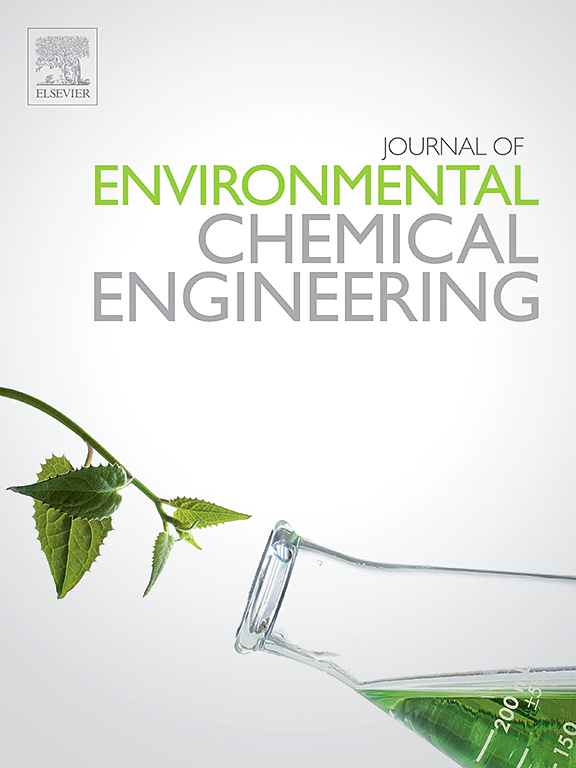Controllable preparation of highly dispersed Ni/γ-Al2O3 catalyst for lipids hydrodeoxygenation to biofuel
IF 7.2
2区 工程技术
Q1 ENGINEERING, CHEMICAL
引用次数: 0
Abstract
Lipids, which derived from waste cooking oil and produced in large quantities, have a naturally intact long carbon chain structure and can be hydrodeoxygenated to prepare second-generation biodiesel. In order to further improve the hydrodeoxygenation (HDO) performances of the Ni-based catalysts, citric acid additive is used to form chelates with Ni2 + , thereby weakening the strong interaction between metal Ni and the Al2O3 support, forming small Ni nanoparticles and improving the dispersion of metal Ni. Characterization and DFT calculations indicate that the interfacial structure formed by Ni and Al2O3 is critical for lipid HDO, and that metallic Ni enables lipid activation and hydrogenation of key intermediates through efficient H2 dissociation. The effects of metal Ni dispersion, metal-support interactions, and metal Ni content on the lipids HDO performances of the Ni/γ-Al2O3 catalysts are investigated in detail. The lipids HDO performances are greatly improved by balancing the metal Ni content and dispersion. The 2CA-6wt% NiAl catalyst has the highest methyl laurate conversion (82.87 %) and alkane selectivity (77.0 %), including the main C11 alkane product with a selectivity of 60.02 %. This work provides a new design method for developing highly efficient lipids HDO catalysts by controlling dispersion.
高分散Ni/γ-Al2O3催化剂的可控制备及其在生物燃料中的应用
油脂来源于废食用油,大量生产,具有天然完整的长碳链结构,可加氢脱氧制备第二代生物柴油。为了进一步提高Ni基催化剂的加氢脱氧(HDO)性能,采用柠檬酸添加剂与Ni2 +形成螯合物,从而减弱金属Ni与Al2O3载体之间的强相互作用,形成较小的Ni纳米颗粒,改善金属Ni的分散性。表征和DFT计算表明,Ni和Al2O3形成的界面结构对脂质HDO至关重要,金属Ni通过有效的H2解离使脂质活化和关键中间体加氢。研究了金属Ni分散、金属-载体相互作用和金属Ni含量对Ni/γ-Al2O3催化剂脂质HDO性能的影响。通过平衡金属Ni含量和分散性,使脂质HDO性能得到了很大的改善。2CA-6wt% NiAl催化剂月桂酸甲酯转化率最高(82.87 %),烷烃选择性最高(77.0 %),其中C11主要烷烃产物的选择性为60.02 %。本研究为控制分散性开发高效脂质HDO催化剂提供了一种新的设计方法。
本文章由计算机程序翻译,如有差异,请以英文原文为准。
求助全文
约1分钟内获得全文
求助全文
来源期刊

Journal of Environmental Chemical Engineering
Environmental Science-Pollution
CiteScore
11.40
自引率
6.50%
发文量
2017
审稿时长
27 days
期刊介绍:
The Journal of Environmental Chemical Engineering (JECE) serves as a platform for the dissemination of original and innovative research focusing on the advancement of environmentally-friendly, sustainable technologies. JECE emphasizes the transition towards a carbon-neutral circular economy and a self-sufficient bio-based economy. Topics covered include soil, water, wastewater, and air decontamination; pollution monitoring, prevention, and control; advanced analytics, sensors, impact and risk assessment methodologies in environmental chemical engineering; resource recovery (water, nutrients, materials, energy); industrial ecology; valorization of waste streams; waste management (including e-waste); climate-water-energy-food nexus; novel materials for environmental, chemical, and energy applications; sustainability and environmental safety; water digitalization, water data science, and machine learning; process integration and intensification; recent developments in green chemistry for synthesis, catalysis, and energy; and original research on contaminants of emerging concern, persistent chemicals, and priority substances, including microplastics, nanoplastics, nanomaterials, micropollutants, antimicrobial resistance genes, and emerging pathogens (viruses, bacteria, parasites) of environmental significance.
 求助内容:
求助内容: 应助结果提醒方式:
应助结果提醒方式:


